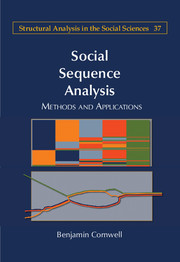Book contents
- Frontmatter
- Contents
- List of Figures
- List of Tables
- Preface
- Acknowledgments
- PART I INTRODUCTION
- PART II THEORETICAL BACKGROUND
- PART III SOCIAL SEQUENCE ANALYSIS CONCEPTS AND TECHNIQUES
- PART IV NEW DIRECTIONS IN SOCIAL SEQUENCE ANALYSIS
- PART V CONCLUSIONS
- Appendix A Recent Whole-Sequence Pattern Analyses
- Appendix B Linkage Criteria for Agglomerative Hierarchical Clustering
- References
- Index
- Recent Books in the Series (continued from page iii)
Appendix B - Linkage Criteria for Agglomerative Hierarchical Clustering
Published online by Cambridge University Press: 05 July 2015
- Frontmatter
- Contents
- List of Figures
- List of Tables
- Preface
- Acknowledgments
- PART I INTRODUCTION
- PART II THEORETICAL BACKGROUND
- PART III SOCIAL SEQUENCE ANALYSIS CONCEPTS AND TECHNIQUES
- PART IV NEW DIRECTIONS IN SOCIAL SEQUENCE ANALYSIS
- PART V CONCLUSIONS
- Appendix A Recent Whole-Sequence Pattern Analyses
- Appendix B Linkage Criteria for Agglomerative Hierarchical Clustering
- References
- Index
- Recent Books in the Series (continued from page iii)
Summary
As discussed in Chapter 5, the key procedural question for an analyst when conducting a hierarchical cluster analysis is what criteria to use when determining whether certain cases or clusters should be merged together at each step of the agglomerative process. This appendix provides some guidance for these decisions. Assume that you are in the middle of the agglomerative process, such that you already have a number of relatively small clusters that contain a handful of cases each. The next step is to determine which of these clusters should be merged together to form larger clusters. The way this is done is that, at each step, clusters that are the shortest distance from each other are merged first. The question is how to define the distance between clusters, which may include several cases that are different distances from each other. This is what the linkage criteria are used to define.
The simplest agglomerative criterion is known as single linkage. In this approach, a given cluster is merged into another when a member of that cluster is close to at least one member of that other cluster. Hence, this requires that only a “single” connection be found between cases in the two clusters before merging them together. This approach is represented in Appendix Figure B.1, which depicts two hypothetical clusters that are being considered for merging. Four panels show different kinds of relationships that one might take into account when using different criteria for merging clusters. The first panel depicts the kind of distance relationship that one would take into account when using the single linkage approach. An obvious problem with single linkage is that it ignores all but one relationship between all of the cases that are present in the two clusters. This approach therefore ignores other relationships, which may be problematic, such as peripheral cases in both clusters that are actually quite distant.
- Type
- Chapter
- Information
- Social Sequence AnalysisMethods and Applications, pp. 270 - 274Publisher: Cambridge University PressPrint publication year: 2015
- 2
- Cited by



